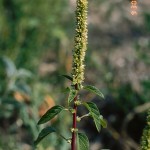Carelessweed, Pigweed, Amaranth
Amaranthus spp.
Amaranthaceae
Description
Carelessweeds are annual weedy herbs belonging to the Amaranth family. Texas has 23 recorded species, which vary in growth forms from prostrate to branching upright. Carelessweed is often called Pigweed because swine relish it. It bears inconspicuous flowers that are typically the same color as the rest of the plant from June to November. The distinct inflorescence feature is the spike shape formed from tiny, clustered flowers.Habitat
Carelessweed abounds on disturbed sites - especially in barnyards with rich, moist soils throughout most of the United States. It is also a common weed in croplands, abandoned lots, roadsides, and sunny field sites.Toxic Agent
Carelessweeds can accumulate nitrates from the soil to toxic levels. Environmental factors often influence nitrate accumulation. For example, nitrate poisoning is more likely to occur if the plant is growing in soils high in nitrogen, especially during drought. Plants containing more than 1 percent nitrate are dangerous. The plant is also known to cause bloat. All ruminants are susceptible to nitrate poisoning.Signs of Livestock Ingestion
Animals with acute nitrate poisoning are often found dead with no previous history of illness. Less acute nitrate poisoning signs often occur in this order: Weakness; Unsteady gait; Collapse; Shallow and rapid breathing; Rapid pulse; Dilated pupils; Delayed abortion; Coma; Death; Blood may appear chocolate brown at the time of death. Pregnant animals surviving acute nitrate poisoning may abort 3 to 5 days later.Management Strategies
Many livestock relish Carelessweed, particularly in its early growth stages. Although it is usually most dangerous during drought, poisonings have occurred at all growth stages and under a variety of conditions. The nitrate content of Carelessweed is significantly higher in the morning than in the afternoon. Keep livestock off heavily infested pastures during early stages of plant growth and after sudden temperature changes. This plant remains dangerous in hay or silage. Because livestock are most often poisoned when they are placed in a pen containing many Carelessweed plants, focus herbicide or mechanical treatments on these areas. The plants' nitrate content may increase immediately after herbicide (especially 2,4-D) treatment; thus, keep livestock away until the plants have dried completely.Images
Plant Characteristics
Flower Color: Green, White, Yellow
Seed Type: Non-Encapsulated
Duration: Annual
Stem Texture: Hairless/Smooth
Growth Habit: Forbs/Broadleaf
Leaf Shape
 : Simple with Pinnate or Parallel Venation
: Simple with Pinnate or Parallel Venation
Season: Warm
Distribution
 : 01 - Pineywoods, 02 - Gulf Prairies and Marshes, 03 - Post Oak Savannah, 04 - Blackland Prairies, 05 - Cross Timbers and Prairies, 06 - South Texas Plains, 07 - Edwards Plateau, 08 - Rolling Plains, 09 - High Plains, 10 - Trans-Pecos
: 01 - Pineywoods, 02 - Gulf Prairies and Marshes, 03 - Post Oak Savannah, 04 - Blackland Prairies, 05 - Cross Timbers and Prairies, 06 - South Texas Plains, 07 - Edwards Plateau, 08 - Rolling Plains, 09 - High Plains, 10 - Trans-Pecos
Distributions
Distribution refers to the ecological region in Texas that a plant has been found. You can also view a clickable map.
Book: Toxic Plants of Texas (B-6105)
Collection: Toxics
Livestock Affected: Cattle, Goats, Sheep
Livestock Signs: Abortion, Coma, Depression/ Weakness, Dilated Pupils, Incoordination, Irregular Breathing, Sudden Death





